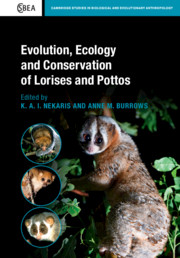Book contents
- Evolution, Ecology and Conservation of Lorises and Pottos
- Cambridge Studies in Biological and Evolutionary Anthropology
- Evolution, Ecology and Conservation of Lorises and Pottos
- Copyright page
- Dedication
- Contents
- Contributors
- Foreword
- Acknowledgements
- 1 Introduction
- Part I Evolution, Morphology and the Fossil Record
- Part II Ecology and Captive Management
- Part III Research, Trade and Conservation
- 24 Trapping, Collaring and Monitoring the Lorisinae of Asia (Loris, Nycticebus) and Perodicticinae (Arctocebus, Perodicticus) of Africa
- 25 Evaluation of Field Techniques Used to Assess Populations of Pottos and Lorises
- 26 Occupancy Modelling as a Method to Study Slender Loris Density
- 27 Using Accelerometers to Measure Nocturnal Primate Behaviour
- 28 Distribution and Conservation Status of Slow Lorises in Indo-China
- 29 Wildlife Trade Research Methods
- 30 Online Imagery and Loris Conservation
- 31 Slow Lorises (Nycticebus spp.) as Photo Props on Instagram
- 32 Integrating Science and Puppetry to Inspire Teenagers in Rural Asia to Value Slow Lorises
- 33 Developing a Rescue and Rehabilitation Centre as a Reaction to the Extensive Illegal Wildlife Trade in Slow Lorises
- References
- Index
26 - Occupancy Modelling as a Method to Study Slender Loris Density
from Part III - Research, Trade and Conservation
Published online by Cambridge University Press: 29 February 2020
- Evolution, Ecology and Conservation of Lorises and Pottos
- Cambridge Studies in Biological and Evolutionary Anthropology
- Evolution, Ecology and Conservation of Lorises and Pottos
- Copyright page
- Dedication
- Contents
- Contributors
- Foreword
- Acknowledgements
- 1 Introduction
- Part I Evolution, Morphology and the Fossil Record
- Part II Ecology and Captive Management
- Part III Research, Trade and Conservation
- 24 Trapping, Collaring and Monitoring the Lorisinae of Asia (Loris, Nycticebus) and Perodicticinae (Arctocebus, Perodicticus) of Africa
- 25 Evaluation of Field Techniques Used to Assess Populations of Pottos and Lorises
- 26 Occupancy Modelling as a Method to Study Slender Loris Density
- 27 Using Accelerometers to Measure Nocturnal Primate Behaviour
- 28 Distribution and Conservation Status of Slow Lorises in Indo-China
- 29 Wildlife Trade Research Methods
- 30 Online Imagery and Loris Conservation
- 31 Slow Lorises (Nycticebus spp.) as Photo Props on Instagram
- 32 Integrating Science and Puppetry to Inspire Teenagers in Rural Asia to Value Slow Lorises
- 33 Developing a Rescue and Rehabilitation Centre as a Reaction to the Extensive Illegal Wildlife Trade in Slow Lorises
- References
- Index
Summary
Animals that are small, cryptic, nocturnal and arboreal are difficult to survey with accuracy. The relative neglect of elusive species is partly due to the additional time, money and effort required to undertake successful studies. This is likely to have contributed to the lorisiforms being named the ‘least known of all the primates’ (Nekaris and Bearder, 2011). Prior to the 1990s, few data existed on the distribution and abundance of slender lorises (Loris spp.), leading to their being listed by the IUCN Red List as Least Concern or Data Deficient. The first contemporary surveys of the distribution of Loris led to identification of one new species and the uncovering of low densities that elevated their threat level (Nekaris and Jayewardene, 2004a; Singh et al., 1999, 2000). Abundance estimates found that slender lorises are patchily distributed, even within a single forest reserve, and despite significant survey efforts some forest patches yielded no sightings (Nekaris and Jayewardene, 2004a). The heterogeneous distribution of Loris has been documented (Kumara et al., 2006; Nekaris and Jayewardene, 2004a; Nekaris et al 2013c; Singh et al., 1999). Encounter rates vary by location, habitat and species (2008). While a number of Loris surveys have now been conducted, the sites, survey modes, sampling techniques and data recorded vary across studies; consequently, results are not directly comparable (Table 26.1).
- Type
- Chapter
- Information
- Evolution, Ecology and Conservation of Lorises and Pottos , pp. 304 - 315Publisher: Cambridge University PressPrint publication year: 2020
- 2
- Cited by



